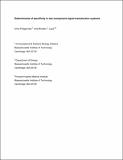| dc.contributor.author | Podgornaia, Anna Igorevna | |
| dc.contributor.author | Laub, Michael T | |
| dc.date.accessioned | 2016-08-29T16:28:20Z | |
| dc.date.available | 2016-08-29T16:28:20Z | |
| dc.date.issued | 2013-01 | |
| dc.identifier.issn | 13695274 | |
| dc.identifier.uri | http://hdl.handle.net/1721.1/104060 | |
| dc.description.abstract | Maintaining the faithful flow of information through signal transduction pathways is critical to the survival and proliferation of organisms. This problem is particularly challenging as many signaling proteins are part of large, paralogous families that are highly similar at the sequence and structural levels, increasing the risk of unwanted cross-talk. To detect environmental signals and process information, bacteria rely heavily on two-component signaling systems comprised of sensor histidine kinases and their cognate response regulators. Although most species encode dozens of these signaling pathways, there is relatively little cross-talk, indicating that individual pathways are well insulated and highly specific. Here, we review the molecular mechanisms that enforce this specificity. Further, we highlight recent studies that have revealed how these mechanisms evolve to accommodate the introduction of new pathways by gene duplication. | en_US |
| dc.description.sponsorship | Howard Hughes Medical Institute (Early Career Scientist) | en_US |
| dc.description.sponsorship | National Science Foundation (U.S.) (NSF CAREER award (MCB-0844442)) | en_US |
| dc.description.sponsorship | National Science Foundation (U.S.) (NSF Graduate Research Fellowship) | en_US |
| dc.language.iso | en_US | |
| dc.publisher | Elsevier | en_US |
| dc.relation.isversionof | http://dx.doi.org/10.1016/j.mib.2013.01.004 | en_US |
| dc.rights | Creative Commons Attribution-NonCommercial-NoDerivs License | en_US |
| dc.rights.uri | http://creativecommons.org/licenses/by-nc-nd/4.0/ | en_US |
| dc.source | Prof. Laub via Courtney Crummett | en_US |
| dc.title | Determinants of specificity in two-component signal transduction | en_US |
| dc.type | Article | en_US |
| dc.identifier.citation | Podgornaia, Anna I., and Michael T. Laub. “Determinants of Specificity in Two-Component Signal Transduction.” Current Opinion in Microbiology 16, no. 2 (April 2013): 156-162. | en_US |
| dc.contributor.department | Massachusetts Institute of Technology. Computational and Systems Biology Program | en_US |
| dc.contributor.department | Massachusetts Institute of Technology. Department of Biology | en_US |
| dc.contributor.approver | Laub, Michael T. | en_US |
| dc.contributor.mitauthor | Podgornaia, Anna Igorevna | en_US |
| dc.contributor.mitauthor | Laub, Michael T. | en_US |
| dc.relation.journal | Current Opinion in Microbiology | en_US |
| dc.eprint.version | Author's final manuscript | en_US |
| dc.type.uri | http://purl.org/eprint/type/JournalArticle | en_US |
| eprint.status | http://purl.org/eprint/status/PeerReviewed | en_US |
| dspace.embargo.terms | N | en_US |
| dc.identifier.orcid | https://orcid.org/0000-0002-8288-7607 | |
| mit.license | PUBLISHER_CC | en_US |
| mit.metadata.status | Complete | |
